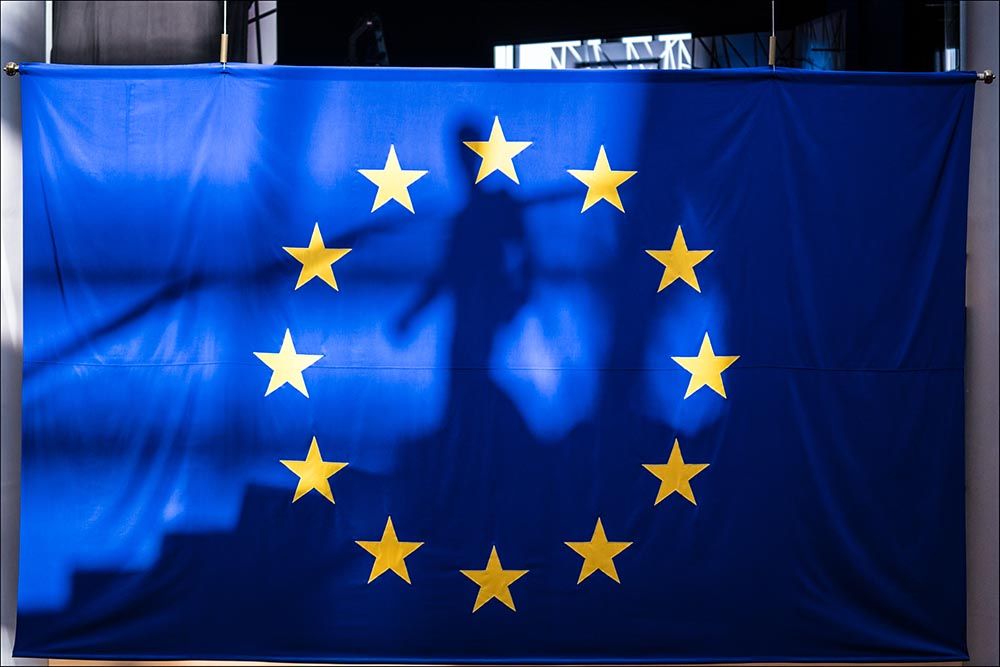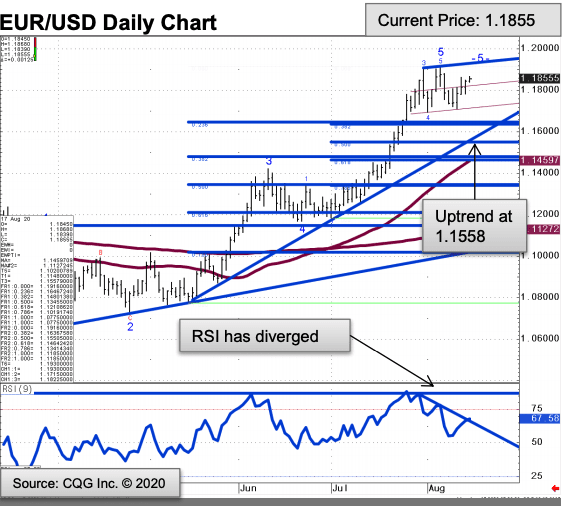Euro-to-Dollar Rate 5 Day Forecast: Improving Technicals, Fed and PMIs Dominate the Calendar
- EUR/USD technicals increasingly supportive
- USD to take direction from Fed mid-week
- EUR to take direction from PMIs on Friday

Image © European Union 2018 - European Parliament, Reproduced Under CC Licensing.
The Euro-Dollar exchange rate has recovered earlier weakness to trade at 1.1850 at the start of the new week, if the pair can close in the green on Monday it will have completed five consecutive days of gains which would underpin an improving short-term outlook.
While the technical setup on the charts is certainly improving, the pair faces potential volatility mid-week when the Federal Reserve releases the minutes from the July meeting while the end of the week sees the release of flash Eurozone PMIs.
"EUR/USD is holding sideways short term, this is serving to neutralise previously overbought indicators and provided that dips remain well supported by both the 1.1646/36 (a double Fibo) and the 3 month uptrend at 1.1558 an upside bias is maintained. This trend line is reinforced by the March high at 1.1495," says Karen Jones, Team Head of FICC Technical Analysis Research at Commerzbank.
The Euro has been appreciating since March 20, when the coronavirus market meltdown finally ended and the Dollar started losing ground as increasingly confident investors started to shift back into 'risk on' assets. A pivot towards the Eurozone as a destination for higher returns in a post-covid world has meanwhile been a particularly supportive pillar of the EUR/USD rally.
However, the EUR/USD advance appears to have faded towards the 1.19 level and analysts have since been asking whether a more sustained retracement is likely. Indeed, we wrote last week that a number of leading strategists were coming around to this idea.
Yet as we move through mid-month the Dollar does appear to be losing momentum and the EUR/USD is looking more constructive as a result.
"A threatened dollar rally has lost its way in recent sessions and a positive bias is beginning to take hold once more on EUR/USD," says Richard Perry, an analyst at Hantec Markets. "With tests of the key support at 1.1695 having been contained, the bulls have now pulled together three consecutive positive candlesticks. Momentum indicators have moderated a threatened corrective slip and are looking to now regain a positive configuration once more."
"After a week of consolidation, we think EUR/USD could go back to test the highs," says Francesco Pesole, FX Strategist at ING Bank N.V. "This relies on the FOMC minutes presenting enough dovish excitement to keep US real yields under pressure. From the EUR side of the equation, this week’s highlights will be Friday’s release of the flash Eurozone PMIs."
Euro Week Ahead: Flash PMIs to End the Week with a Bang
The main data release for the Euro in the week ahead ahead are the flash PMIs for August which will give a sense of how the respective recoveries in the Eurozone and UK are progressing.
"Activity likely rose gradually through August as most countries continued to ease up COVID restrictions (local shutdowns excepted). We see upside risks and expect small gains across most key PMI measures, indicating recovery, but still at a relatively subdued pace," says a note from TD Securities.
Eurozone PMI data are out at 09:00 BST on Friday, while the UK PMIs are out at 09:30.
With relative economic performance being an increasingly important factor for foreign exchange markets to consider, a beat or miss of consensus forecasts could influence direction in the Euro and Pound.
Eurozone Manufacturing PMI is forecast at 53.0, up from the previous month's 51.8.
Services PMI is forecast 54.2, up slightly on the previous month's 54.7 while the composite PMI - which combines the two but weighs them according to their respective share of economic activity - is forecast at 54.7, down slightly on July's 54.9.
"The PMI data in the next couple of weeks could confirm the view that the economic recovery in Europe and Asia has gained further momentum," says Valentin Marinov, Head of G10 FX Strategy at Crédit Agricole.
The rule of thumb remains that the Euro should rally if the data beat expectations, but a disappointment could draw attention to rising covid-19 infections around Europe and contribute to a softer Euro.
Secure a retail exchange rate that is between 3-5% stronger than offered by leading banks, learn more.
U.S. Dollar Week Ahead: Democrat Politics and the Fed
The data calendar for the U.S. this week is distinctly uneventful, allowing the market to focus on politics and Federal Reserve policy.
The Democratic National Convention will kick off the 2020 presidential election season, with the party officially selecting Joe Biden and Kamala Harris as its nominees for president and vice president.
What matters for markets are hints at where economic policy under a Biden presidency will go; indeed we noted in a piece out earlier this month that expectations for a Biden victory could have been a driving force behind a weaker U.S. Dollar.
"Given that Trump administration policymaking has promoted a stronger USD in recent years, markets are likely to associate a potential changeover to Biden with a weaker USD. It is early days to venture forecasts about such changes, but these are certainly important factors to watch," says Thomas Flury, Strategist, Chief Investment Office at UBS.
According to Crédit Agricole research, U.S. Dollar losses were more pronounced when the incumbent was heading for defeat.
"Market concerns that such a scenario may materialise could lead to renewed USD losses in the coming months," says Valentin Marinov, Head of G10 FX Research & Strategy at Crédit Agricole.
A change in guard would naturally go some way in overturning Trump's policies that were ultimately supportive of the Dollar.
According to Crédit Agricole, there are five reasons why a Democrat president could be less supportive of the U.S. Dollar:
- Fiscal austerity measures (including higher taxes) may be needed to address the significant deterioration in the US
- Fiscal deficit and accommodate calls for an overhaul of the healthcare system
- Less aggressive protectionist policies especially against NATO allies in Europe
- More regulation for energy and financial companies
- The White House ‘influence’ over the independent Fed could ease
- Producing a potentially weaker growth outcome than if President Trump is re-elected
The Democratic National Convention is expected to provide some details as to where their economic policy will land come November.
The main economic event on the calendar for the U.S. Dollar this week will be the release of the minutes from the Federal Reserve's July policy meeting.
"At the July FOMC meeting the Committee did not initiate any new policy actions and changes to the statement were minor. While the Fed chairman did not provide any major details on the review, or forward guidance, he did suggest that the review will "wrap up… in the near future." We expect the minutes to provide additional colour on how those discussions are evolving," says a note from TD Securities.
The general rule of thumb in foreign exchange markets is that when a central bank eases policy, the currency it issues tends to fall in value. The Fed has this year embarked on an unprecedented policy of easing, by lowering interest rates, boosting quantitative easing and introducing numerous programmes aimed at assisting the U.S. economy.
A move to further easing measures in anticipation of a weaker economic outlook would naturally weigh on the Dollar.
"Minutes of the July FOMC meeting are released on Wednesday and any suggestion of impending Average Inflation Targeting (AIT) or Yield Curve Control (YCC) would be a dollar negative. On balance we would prefer to back the latter story... meaning that the DXY could make a new low," says Chris Turner, Global Head of Markets and Regional Head of Research for UK & CEE at ING Bank.





